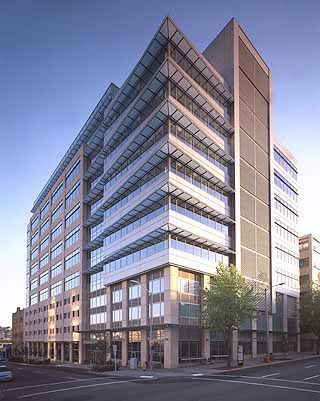
DJC.COM
March 3, 2005
How one local developer took the biotech plunge
Touchstone Corp.

Photo courtesy of MBT Architecture
Seattle’s 9th and Stewart Life Sciences Building, developed by Touchstone Corp., was designed to appeal to biotech tenants. Features include a low-vibration structural frame and 15-foot floor-to-floor heights to accommodate lab equipment.
|
Seattle has had a small biotechnology base here for many years.
The life sciences pioneers in Seattle were the University of Washington and the Fred Hutchinson Cancer Research Center. From these beginnings companies such as Corixa, Immunex, Zymogenetics and Seattle Biotechnology Research Institute were created, to name just a few.
Now greater Seattle has nearly 200 biotechnology and biomedical companies. Although this is a growing core business for Seattle, its growth is nothing like the dot-com industry of the late 1990s. Some years see many new companies appear, with some even bringing the newest blockbuster drugs to market. Other years, companies struggle just to raise enough cash to keep the doors open.
This industry will continue to march forward, but its progress definitely has an ebb and flow.
When you talk to an employee of a biotech company, they have "history." Nearly everyone used to work for another company, either one that was bought out or a company that just went out of business. Some have just changed jobs. The point is that people do not go away in this industry, unlike many others — you never hear of researchers working at the lumber yard because they couldn't find a job.
Why biotech?
Touchstone Corp. has been a local real estate developer for more than 20 years. The projects we've done recently are very complicated both from the real estate side as well the construction side.
When the dot-com office market was still booming we decided to venture into biotech building development. We were profiting from the outstanding office market and the single-digit vacancies but, as a small company, we wanted to create a niche for ourselves in the development market.
At this point, biotechnology was an industry that had a small cluster in Bothell and was scattered about the Seattle market in adaptive re-use buildings. For most developers, biotech wasn't even on the radar screen, except for the occasional build-to-suit. But we believed Seattle's biotech and biomedical industry was growing and would continue to grow.
We became committed to this "new" industry, and wanted to provide these companies with a development team that understood their business and their specialized building needs. Then the dot-com office market died off as quickly as it started. This brought biotech development into the light.
Soon several developers were in the biotech market and their buildings became "lab" facilities. This was the new hope to fill the space vacated by the dot-com crash. However, the inflow of developers into this market soon dwindled as the need for facilities stabilized.
Building on spec
Touchstone moved to become a developer that specializes in these complex facilities. Prior to any specific development, we educated ourselves by traveling to the major biotech markets. We toured buildings in San Francisco, San Diego and Boston. We met with users, researchers, engineers, brokers and investors.
The more we learned and understood, the more questions we had.
Biotech buildings have rigid structural frames to minimize microvibrations in the building, and they have high floor-to-floor ceiling requirements to allow the piping and ductwork to be installed.
The buildings need boilers, chillers and sophisticated HVAC equipment. They are large power users and have an infinite number of special requirements such as hazardous material storage, vivariums and clean rooms. We were beginning to see that each company had unique needs.
Could we develop and build a speculative biotech building and attract capital investment?
We set out to define biotech buildings into a generic product that would work for many lab users. We came to realize this was nearly impossible. Just the kind of challenge we enjoy.
9th and Stewart
The 9th and Stewart Life Sciences Building in Seattle is the result of more than five years of planning, designing and finally construction. This building is likely one of the most unique biotech developments in the country.
We created infrastructure, redundancy and flexibility able to accommodate a variety of users. The project has a unique structural frame to provide low vibration without excessive cost. It has a 15-foot floor-to-floor height to accommodate most lab installations, redundant chillers and generators with expansion space, and expandable shaft space for vertical risers. An entire side of the building is removable to accommodate HVAC equipment. The roof has a fan farm for tenant use.
The list of features goes on and on, but the building was completed on time and under budget — at a cost not much more than a similar general office building.
The 9th and Stewart Life Sciences Building was named NAIOP's 2004 technology space of the year in Washington. The success of this project is due to the years of work and planning that went into it and the incredible development, design and construction teams who kept going, even when the project presented problems that seemed to have no solutions.
Shawn Parry is vice president of construction and project management for Touchstone Corp. of Seattle and one of its three principal owners.
Other Stories:
- Building a foundation for biotech
- Can Seattle become a first-tier biotech hub?
- Laptops, Treos and phones! (Oh my!)
- Form follows function, even for biotech
- Build it right and they will come
- New buildings bring science into the city
- 6 myths about building for biotech
Copyright ©2009 Seattle Daily Journal and DJC.COM.
Comments? Questions? Contact us.